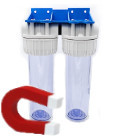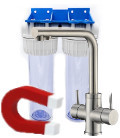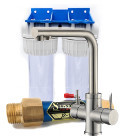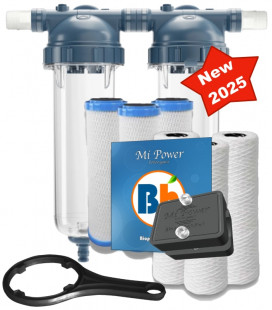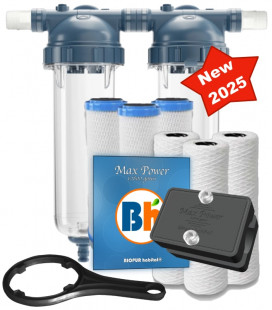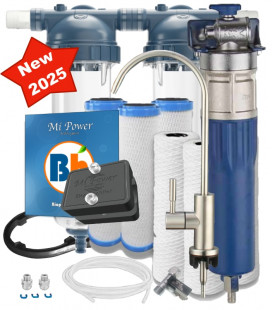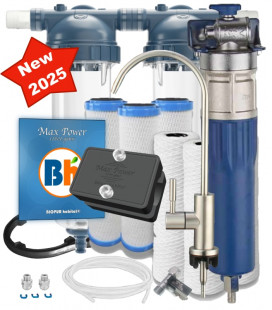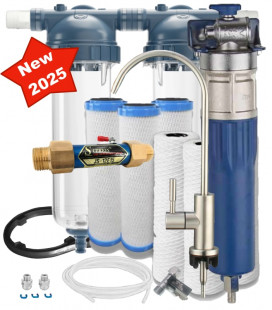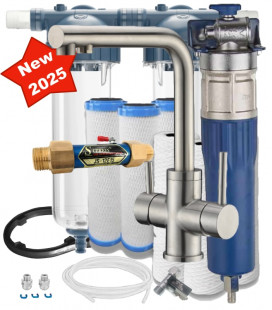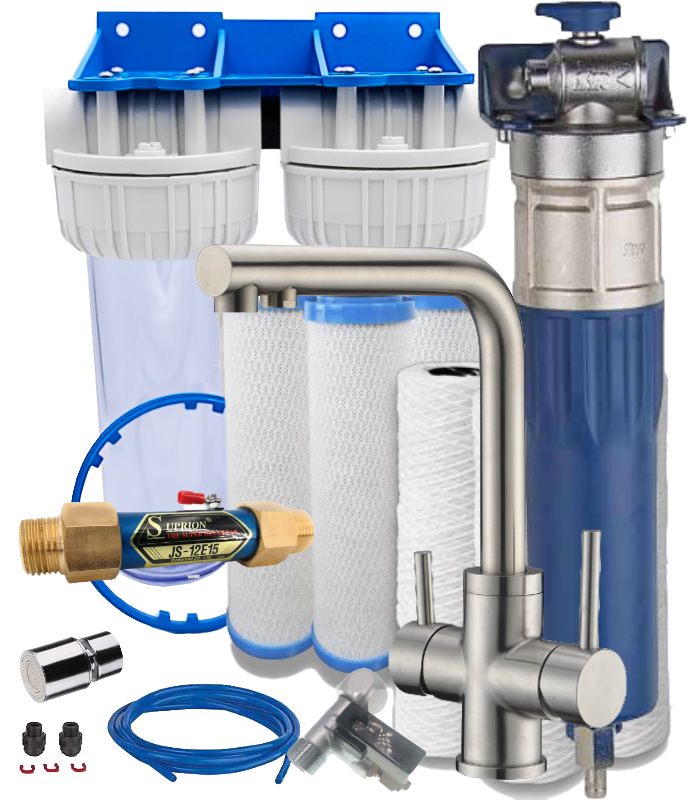No products
Prices are tax included
Anti-limescale filter and water purifier kit
Why opt for a product package?

In order to achieve optimum results in water treatment, it will be necessary to use elements that are complementary and whose role will be essential to obtain good performance in filtration, limescale treatment or water purification.
These packs also include accessories that are not always easy to find in the shops, which will allow you to simplify the installation of your anti-limescale water purification system, such as a tap for a reverse osmosis system, a 3-way tap or a T-connector to add a cold water supply to the water purifier...
The aim of these packs is to offer you different anti-scaling and water purification solutions at different levels of performance and price.
Also, the fact of being able to offer all these products to the same buyer has allowed us to further tighten the proposed price.
1 - The household water filter
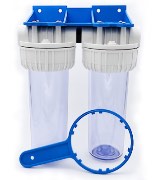
This filter is the main starting point for your future installation. In spite of the treatment and analyses that are carried out upstream by the water treatment companies, an alteration will occur in the downstream distribution.
Drinking water is made up of various dissolved minerals and organic matter that will react and transform on contact with the walls. The result is a deposit of limestone, manganese oxide or iron oxide. This crust that forms in the pipes of the water distribution network is also called biofilm. It will also form within a few months on new materials.
Made up of micro-organisms (bacteria, protozoa, etc.) and mineral deposits, it develops, as on the walls of an aquarium. Its thickness can vary from a few microns to even 1 centimetre.
This biofilm is a living organism (about 107 cells per cm²). After a while, it will partially detach and flow freely through our pipes. "It then functions as a small biological reactor. Even if it seems benign, it is pathogenic germs (legionella, faecal coliforms, etc.) that it can harbour and which can cause problems. The micro-organisms normally remain encapsulated in this biofilm and if no bacteria enter the water system, there is almost no risk.
The role of this pre-filter will be to retain these elements in order to trap them and mechanically protect our appliances from the abrasion that they can also cause. It is also the way to avoid the formation of sludge and deposits that could be found in our household appliances, boilers and hot water tanks.
It can be found in the form of filter holders whose cartridges will have to be replaced regularly (annually depending on the degree of clogging) or in backwash systems that avoid the use of consumables. Without the need for special technologies, the drop in water pressure at the outlet of the taps warns of the need to change.
2- the activated carbon cartridge
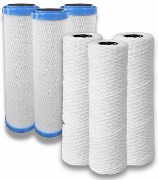
Activated carbon is a material consisting mainly of carbon with a porous structure.
It has a high degree of binding and retention of certain molecules on contact. It is an amorphous structure composed largely of carbon atoms whose high adsorbing power is due to its high specific surface area.
Its role; the decontamination of drinking water by retaining :
- pesticides
- chlorine removal
- lead removal
- heavy metals
- nitrates
- hormone residues
- organic residues
Thanks to its use, one can notice an improvement on the taste quality of water, its smell, digestion, itching of the skin...
It is a definite asset to provide your body with healthier water and improve your overall health.
It can be used alone or doubled up for greater efficiency, usually with filter doors. For a 4-person dwelling and according to its consumption, it will be necessary to plan a replacement about every year.
Its filtration degree of 5 to 10 microns will not reach that of a water purifier which filters at 0.1 microns.
A finer filtration would result in a considerable loss of water flow and pressure. It is therefore only recommended for use on a kitchen tap. (see further in article 4 - water purifier)
It should be placed after a sediment filter so as not to clog it unnecessarily with sediment and cause it to lose its pollutant adsorption properties.
3 - salt-free water softener
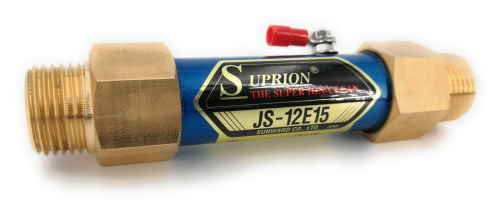
As a reminder, we use the term water softener in the same way as the term anti-limescale, anti-scaling or water conditioner.
All systems with different technologies could be grouped into one category: anti-limescale
The term water softener is the most widely used because it is one of the oldest technologies to have been marketed and therefore the best known.
In everyday language, water softener has become a synonym for all these appliances, in the same way that we speak of a Karcher for a high pressure cleaner, a pen for a pen or a hamburger for a sandwich that does not necessarily come from Hamburg in Germany or contain ham!
Whether by magnetic, electrostatic, induction or other fields, the salt-free water softener will use technologies that allow calcium and magnesium to no longer combine into scale. It will neutralise the formation of limescale.
These devices are not filters, they will not remove minerals and impurities from the water. Some will even remove scale that has already formed, these are called curative devices.
Why choose a salt-free water softener?
- environmentally friendly
- durable material
- preserved drinking water quality (mineral conservation)
- does not require maintenance
- does not wear out
- simple and space-saving installation
- low cost of material and installation
- no consumables.
Good to know: when the water does not circulate for several days in the pipes, the systems will no longer work and the limescale will start to build up again. For long term quality of use, curative systems are to be preferred as they will eliminate any new crystals that may form over time.
4 - the water purifier
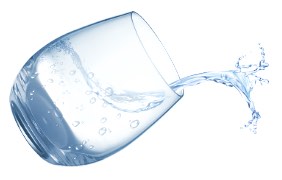
Why not use plastic mineral water bottles:
- plastic leaks into the bottle! Water contains plastic micro-fibres
- you might find phthalates but also bisphenol
- plastic bottle factories are polluting
- the transport of plastic bottles is also polluting
- you are paying and supporting private companies that exploit a resource that belongs to everyone
- controls on bottled water are less strict than for tap water in France
- very different waters depending on the brand in terms of taste, salinity, nitrates
- not always authorised for pregnant women and children
Why filter tap water?
- water pollution peaks before treatment and excess treatment products
- chlorine
- nitrates
- pesticides
- drug residues
- traces of heavy metals
- pollutants from pipes
- micro plastics
The amount of water to be treated and delivered to our taps is significant. There will inevitably be a lag time and pollution "peaks" between the time when we need to modify the treatments and the time when the water continues to be delivered to us.
Even if the water is heavily analysed and treated before it is distributed, the problem often lies afterwards. It will pass through various pipes buried in the ground and can deteriorate depending on their state of disrepair, their watertightness, the materials from which they are made, the deposits...
Water is a very good solvent in which almost everything mixes! It is impossible to control all the elements it contains, even as new pollutants appear.
More and more official studies are concerned about the "cocktail effects" and mixtures of certain products. Some can be active even at low doses. Purifying water is therefore not only about the quality you get and the improved taste, but also about preventing future risks: bottled water compared to tap water
- 191,58 € tax incl. 239,48 € 100In StockReduced price!
The pack will be effective for a water flow rate used for up to 3-4 people and 1 bathroom.
If the water flow rate is higher, you will have to choose another more suitable model from our range. - 256,80 € tax incl. 321,00 € 100In StockReduced price!
This kit is suitable for a water flow rate corresponding to the use of a family of 4 to 5 people and up to 2 bathrooms.
For larger water flows to be treated please see our Suprion range. - 506,68 € tax incl. 611,58 € 100In StockReduced price!
This anti-limescale and water purifier kit is designed for a small dwelling.
The water pipe should not exceed 20mm inside for the water flow to be treated correctly.
Less scale formation and healthier water. - 567,30 € tax incl. 681,58 € 100In StockReduced price!
This anti-limescale and purifier pack is designed for a standard home of 4 to 5 people.
Cleaner water and neutralized limescale formation. - 846,54 € tax incl. 1 058,18 € 100In StockReduced price!
Pack with additional 1-way tap
Designed for a water flow used by a small dwelling of less than 4 people and 1 bathroom maximum- The filter will retain the largest impurities and some pollutants
- the anti scale will by its electrostatic process prevent the formation of scale
- The 4-stage filter purifier will purify the water available at the sink
- 892,14 € tax incl. 1 115,18 € 100In StockReduced price!
Your ionic water softener with all accessories included
For a dwelling with up to 2 bathrooms- The filter will retain the largest impurities as well as certain pollutants
- the anti-scale by its electrostatic process will prevent the formation of scale
- The 4-stage filtration purifier will purify the water available at the sink

